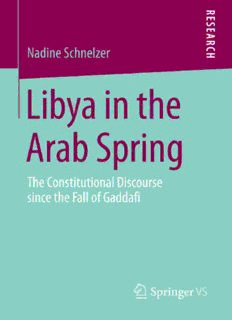Table Of ContentLibya in the Arab Spring
Nadine Schnelzer
Libya in the Arab Spring
The Constitutional Discourse
since the Fall of Gaddafi
Nadine Schnelzer
Erlangen, Germany
ISBN 978-3-658-11381-0 ISBN 978-3-658-11382-7 (eBook)
DOI 10.1007/978-3-658-11382-7
Library of Congress Control Number: 2015950194
Springer VS
© Springer Fachmedien Wiesbaden 2016
This work is subject to copyright. All rights are reserved by the Publisher, whether the whole or
part of the material is concerned, speci(cid:191) cally the rights of translation, reprinting, reuse of illus-
trations, recitation, broadcasting, reproduction on micro(cid:191) lms or in any other physical way, and
transmission or information storage and retrieval, electronic adaptation, computer software, or by
similar or dissimilar methodology now known or hereafter developed.
The use of general descriptive names, registered names, trademarks, service marks, etc. in this
publication does not imply, even in the absence of a speci(cid:191) c statement, that such names are
exempt from the relevant protective laws and regulations and therefore free for general use.
The publisher, the authors and the editors are safe to assume that the advice and information in this
book are believed to be true and accurate at the date of publication. Neither the publisher nor the
authors or the editors give a warranty, express or implied, with respect to the material contained
herein or for any errors or omissions that may have been made.
Printed on acid-free paper
Springer VS is a brand of Springer Fachmedien Wiesbaden
Springer Fachmedien Wiesbaden is part of Springer Science+Business Media
(www.springer.com)
Acknowledgements
I wish to take this opportunity to thank those who particularly supported me on
mywaytothiswork.Firstandforemost,IwishtothankmylateprofessorChris-
toph Schumann. His philosophical digressions in class and his invitations to see
thingsdifferentlywereanimportantreasonwhyIbecamesoabsorbedbymystud-
ies. This book is a monograph, but several people have provided me with indis-
pensable support on writing it. I extend my thanks to my academic supervisor,
DrJörnThielmann,forsupportingmywork.AyatMneinafromtheLibyanYouth
Movement,whomImetatanexhibitiononLibya’shistoryinOslo,putconsider-
abletimeandeffortintometiculouslyreadingandcommentingonthemanuscript.
I very highly value her positive feedback. For proofreading, I owe gratitude to
KateHunter.IthankSpringerVSforpublishingthisbook.
Erlangen,April2015 NadineSchnelzer
ForProf.DrChristophSchumann,
who fathered myintellectual development.
Contents
1 Introduction ......................................................................................... 11
2 State of Research, Theoretical Assumptions, Methodology ............. 17
3 From the Monarchy to the Fall of Gaddafi ....................................... 31
3.1 Libya as a Federal Monarchy ..................................................... 31
3.2 Totalitarian, Centralist State under Gaddafi ............................... 33
3.3 Phases of Totalitarian Rule ......................................................... 36
3.4 Collapse and New Beginning from 2011 ................................... 38
4 Libya’s Society ..................................................................................... 41
4.1 National Unity ............................................................................ 41
4.2 Neo-Tribal Associations in Libya .............................................. 43
4.3 Religious Aspects ....................................................................... 47
4.4 Ethnic Minorities ........................................................................ 49
4.5 Women ......................................................................................... 51
5 The Libyan Constitutional Discourse ................................................ 55
5.1 From NTC to Constitutional Committee Election ...................... 56
5.2 Public Spheres and Addressees .................................................. 58
5.3 New Actors and Political System ............................................... 59
5.3.1 Islamist Current ............................................................... 63
5.3.2 Civil Society Organisations ............................................ 66
5.4 Discursive Threads ..................................................................... 67
5.4.1 Democracy ...................................................................... 68
5.4.2 Federalism, Decentralisation, Localisation ..................... 70
5.4.3 The Role of Religion in Politics ...................................... 75
5.4.4 The Role of Women ........................................................ 78
5.4.5 Recognition of Identity ................................................... 84
6 Conclusion ............................................................................................ 89
Bibliography .................................................................................................... 93
Appendix ........................................................................................................ 103
9
Theruler'scloakdidnotsimplyclingtohisbodynow.Theleathernrobewasno
longeratightgarmentashehadoriginallythoughtitwouldbe.Ithadactually
turnedintoasecondskin.Indeed,itwashisskinnow.
Ibrahimal-Koni,DasHerrscherkleid
1 Introduction
FromFebruaryuntilOctober2011,acivilwar1waswagedinLibya.Theinterfer-
enceofNATOhelpeddecidethewarinfavouroftherevolutionaries.Theoutcome
wasthetotaldestructionofgovernmentandadministrativeinstitutionsaswellas
thedeathofMuammarGaddafiandthelapseofhisideologyaslaiddowninthe
GreenBook.NowLibyaisinneedofanewconstitution.
Uptonow,nonewconstitutionhasbeendraftedandtheConstitutionalDec-
larationdeliveredon3August2011bytheNationalTransitionalCouncil(NTC)
has been the framework of reference. Since 2011, there have been two general
elections,thefirsttotheGeneralNationalCongress(GNC)andthesecondtothe
Constitutional Committee. The delayinthe constitutionalprocesshasleftnewly
createdinstitutionswithlittlelegitimacy,buthasalsogiventheconstitutionalde-
bate time to flourish. The totaldestructionof the politicalsystem under Gaddafi
necessitatesand opensthe door to a newinstitutionaldesign. While the political
systemmustbecreatedfromscratch,thepoliticalpersonnelarestillthere.Some
have resurfaced from exile, some already held positions in the Gaddafi era, and
othersarenewcomerstothepoliticalscene.Theycompeteforpositonsandinflu-
ence in the ‘new’ Libya, relying on armed brigades, or militia, to throw weight
behindtheirdemands.Atthesametime,NGOshavemushroomed,ashaveother
organisationsandeventstodiscussthe futureofLibya.The wholecountryisin-
volvedinadiscourseabouthowLibyashouldbeconstituted.
1Theauthor’suseofthetermsrevolution,civilwaranduprisingfollowWolframLacher's
use:LacherreferstoCharlesTillyanddefinesrevolutionasasituationinwhichcontenders
raisecompetingclaimstocontrolthestate,asignificantsegmentofthepopulationcommits
tothoseclaimsandtherulersareunableorunwillingtosuppressthatchallenge.InLibya,
wecanalsospeakofarevolutionduetothecompletecollapseofthepoliticalorder,neces-
sitatingtheestablishmentofaneworder,andwithrespecttothesacrificesofthosewho
tookpartintheuprising.Acivilwar,inshort,meansmilitaryactionwithinastatewiththe
participation of the government and at least 1,000 deaths in total per year. Uprising is a
moregenerictermfortheeventsthathaveunfoldedsinceFebruary2011,startinginBen-
ghazi.(Lacher2013a,pp.168–169)
11
N. Schnelzer, Libya in the Arab Spring, DOI 10.1007/978-3-658-11382-7_1,
© Springer Fachmedien Wiesbaden 2016
This research paper aims at portraying the Libyan constitutional discourse
since2011.Whoarethekeyactorsandcentralissuesdiscussed,andhowdoesthe
developmentofthediscourse relatetoLibya’shistoryandsociety?Theperspec-
tive fromthe origin of the debate rather than an anticipated future will focus on
theprogressratherthanfailureofpoliticaldevelopmentsinLibya. Ahistoricisa-
tionoftheconstitutionaldiscoursereducestheleveragefornormativecriticismof
thecourseLibyahastaken.Adiscourse-theoreticalviewpointalsohighlightsthe
longevityofanydiscourse,sincediscoursescanlastsolongthattheytakeonthe
airofnaturallaws:“Byconstantrepetition,thosepracticesdevelopintostructures
intheformofdiscourseswhichcanbecomesonaturalthatweabstractfromtheir
societal origins, that the latter are forgotten and seem to be natural laws” (Be-
lina / Dzudzek 2009, p. 131). Moreover, understanding in the true sense of it as
defined byHannah Arendt requires context. Ideas, concepts and images integral
to a culture must be familiar to the interpreter to make sense of things (Richter
2004,p.15).Thedemandforfederalism,forexample,raisedintheconstitutional
discourse bears no meaning in itself and must be put into the specific historical
contextofLibya.
In this study, members of the transitional law-making institutions and their
militia supporters as well as civil society representatives and influential figures
fromthespectrumofpoliticizedIslamareidentifiedaskeyactorsintheconstitu-
tionaldiscourse.Socio-politicalcleavagesandkeyissuesintheconstitutionalde-
batearedemocracy,federalismanddecentralization,theroleofreligioninpolitics,
the political inclusion of women and minority rights. Besides, a look at the lan-
guage usedandpublic addressedbyparticipantsinthediscourse willrevealrec-
ognizeddecision-makinginstances.Theapplicationofdiscoursetheorymakesit
possibletogarnervisionsand expectationsofanewconstitution2thatwouldnot
lendthemselvestoobservationandresearchifonlythosevoicedinofficialdocu-
mentsorateventsdiscussingthenewconstitutionwereconsidered.Demandsre-
latingtotheconstitutionarealsomadeincontextsandontopicsthatareseemingly
unrelatedtothedraftingoftheconstitution.Drawingontheessentialassumption
ofcriticaldiscoursetheorythatdiscourseisshapedbyandshapessociety,itwill
be evidenced that the discourse evolving around the future constitution itself
shapes not onlythe constitution-drafting process, but also creates facts that con-
tributetothecurrentandfutureconstitutionofLibya.Asanexample,thedebate
aboutthequotaofseatsreservedforwomeninelectionstotheGNCwasboththe
2 Theterm‘constitution’hasadoublemeaning: itstandsbothforalegal document that
laysdown,amongotherthings,thepoliticalsystemofastateaswellasastateandcondi-
tion.
12
Description:This book sketches the discourse about a new constitution in Libya since 2011. Applying a discourse analytical approach, the author identifies societal cleavages that have come to the fore in Libya’s transitional period. The debate has focused on democracy, federalism, decentralisation and localis

